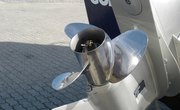
A boat propeller's size is described by its diameter and its pitch. When you measure a boat propeller, you don't simply measure the length of one of the blades, you also have to measure and calculate the size of the circle made by the tip of a blade as it moves. You also have to measure and calculate the distance--in inches--that each full turn of the propeller moves the boat forward, a measurement call the propeller's "pitch." With a few simple tools, some addition and some multiplication, you can accurately measure your propeller.
Items you will need
Tape measure
Grease pencil
Protractor
Calculator
Measure from the center of the propeller's hub--the center of the propeller to which the blades are attached--to the edge of the hub with a tape measure. Record this measurement.
Measure from the base of one blade to the tip of that same blade. Record this measurement.
Add the two recorded measurements together and multiply the result by 2 to determine the diameter of the propeller, which is the first element of the propeller's measurement. For example, If the distance from the center of the hub to the edge of the hub is 1 1/2 inches and the distance from the base of the blade to the tip of the same blade is 5 1/2 inches, then: 5 1/2 + 1 1/2 = 7 inches. This is the radius of the propeller. Multiply the radius by 2. 7 x 2 = 14 inches, so the first element of the this propeller's measurement is "14."
Use the grease pencil to draw a line around the propeller hub. Set the base of the protractor against the blade of the propeller and note the angle (on the protractor) between the blade of the propeller and the line drawn around the hub. Use your calculator's "TAN" or tangent function to determine the tangent of this angle.
Multiply the tangent of the angle by 6.2831. Multiply the result by the radius of the propeller. The result is an approximation of the pitch. Pitch is always a whole number; if you get a fractional answer, round the number off. For example, if the diameter of the propeller is 14 inches, the radius of the propeller is 7 inches. The angle of the blade is 20 degrees. The tangent of 20 is 0.36397. 0.36397 x 6.2831 x 7 = 16.0080. Rounded off to the nearest whole number, this means that the pitch of the propeller--the second element of this propeller's measurement--is "16."
Record your propeller's measurement by its diameter and its pitch. In the example, the diameter is "14" and the pitch is "16." The propeller measures "14 x 16."
Tips
- Your propeller's pitch and diameter are engraved or stamped on the hub of the propeller. If these numbers have worn away, keep a record of your calculations for future reference.
References
Tips
- Your propeller's pitch and diameter are engraved or stamped on the hub of the propeller. If these numbers have worn away, keep a record of your calculations for future reference.
Writer Bio
Will Charpentier is a writer who specializes in boating and maritime subjects. A retired ship captain, Charpentier holds a doctorate in applied ocean science and engineering. He is also a certified marine technician and the author of a popular text on writing local history.



